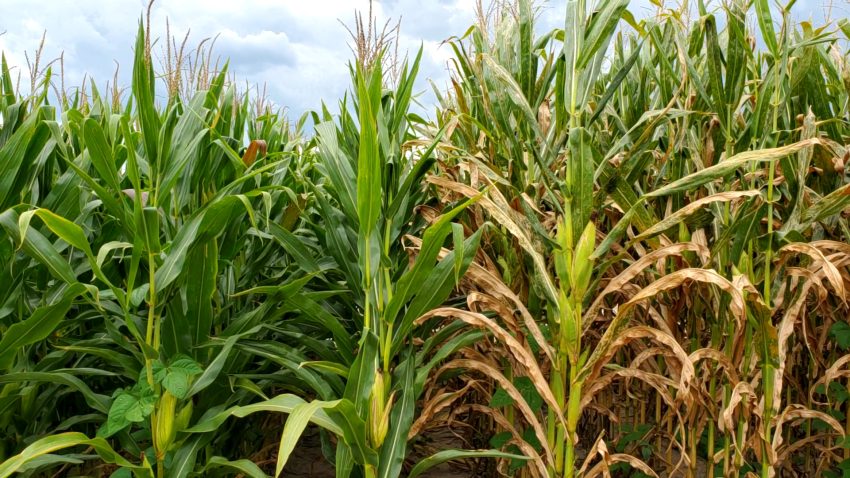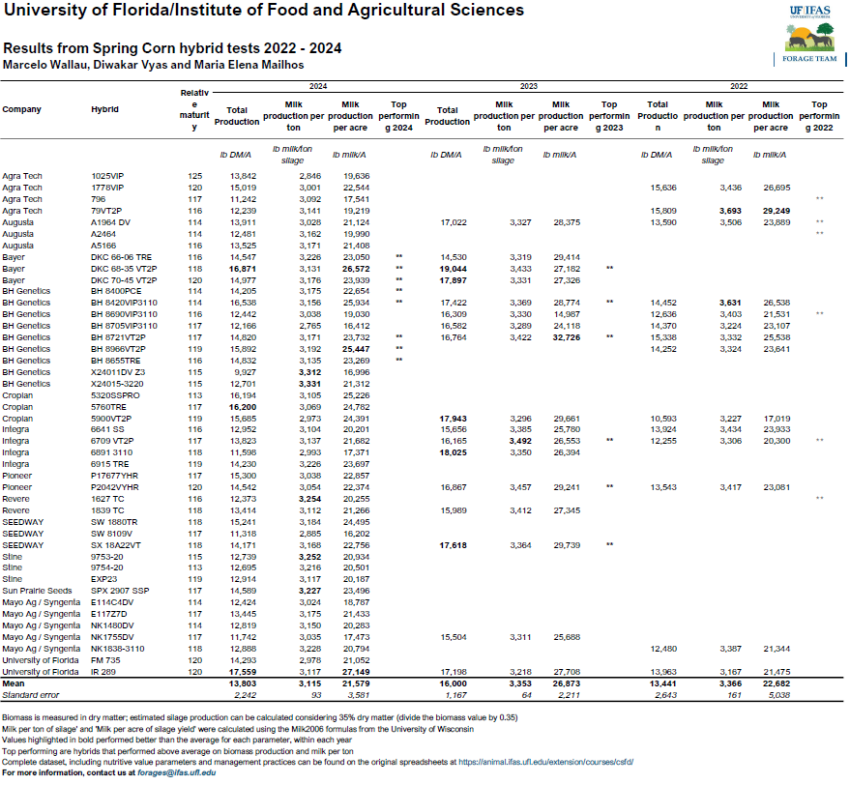Marcelo Wallau, Olivia Maule, Ashley Kanobroski (UF/IFAS Agronomy Department, Forage Team), and Diwakar Vyas (UF/IFAS Animal Science)
Despite the recent record snowfall and cold weather, it is almost time to get started with corn season in North Florida. Many farmers are already planning and securing seeds to plant in late February and early March.
To help with those decisions, we featured Dr. Bill Mahanna on the latest episode of the Cow Talks podcast. Dr. Mahanna, Global Nutritional Sciences Manager with Pioneer, shared great insights into choosing corn hybrids for silage. According to him, prioritizing agronomic traits—such as yield stability, starch content, disease resistance, and late-season plant health—is more important than focusing solely on fiber digestibility.
Why? Fiber accounts for about 25% of the total energy in corn silage, while starch contributes up to 65%. Environmental factors and maturity largely determine fiber digestibility, except for brown mid-rib (BMR) hybrids. In the end, there is not much difference between materials grown in the same conditions (which we observe in our trials). Moreover, if we cannot grow a good crop, there is no good silage. Hence, Dr. Mahanna’s key takeaways are to focus on growing a strong crop by selecting hybrids with solid agronomics, starch content, and late-season plant health (Figure 1), then fine-tune the nutrition afterward. Yes, he knows that many nutritionists will not agree, but there are tools to balance a better diet later. Bill also mentions the importance of talking to your local agronomists, seed salespersons, and other farmers to see what is growing best for them. These individuals have a lot of field knowledge, pair that with results from various trials to see what will work best for you.

Figure 1. Late-season difference in plant health for two corn hybrids growing under the same conditions and management. Disease and, consequently, dead leaves will result in reduced production and fiber digestibility.
–
Since 2008, we have tested commercial and experimental hybrids of corn, sorghum, sorghum x Sudan, and millets, providing unbiased data on performance, disease tolerance, and nutritive value. The results are designed to help producers make better informed variety selection decisions. The trial data is available through our UF Silage Hybrid Decision Tool and the Corn and Forage Silage Field Day website (excel spreadsheets). For added convenience, we’ve created a video guide to help you navigate the tool, which allows you to sort by traits, compare across seasons, and select your favorite companies. We’ve also compiled a three-year spreadsheet to compare hybrid performance over time, which you can see in the PDF files below (excerpt in Figure 2.)
2022-2024 Corn silage trial
2022-2024 sorghum silage trial
–

Figure 2: Excerpt from data spreadsheet comparing the results of the last three years of corn hybrid trials. For the PDF document, click on the links above.
–
A Quick Note on Cool-Season Forages
If you’ve planted cool-season forages, the recent cold snap has likely slowed growth. Cool-season forages will grow only when temperatures exceed 45° F. The cold has also reduced organic nitrogen mineralization from effluents, further limiting growth. If that is your sole source of N, those forages are probably looking yellow. Delaying corn planting by just a few weeks, to allow the cool-season forages more growing time under favorable conditions, could increase forage biomass by 800–1,200 lbs of dry matter per acre (or 2,200–3,600 lbs of silage), depending on fertility. Timing is critical to maximize yields, if that fits your planning and your contract harvester is flexible.
–
We are accepting entries for hybrid trials
For companies who carry or develop corn, sorghum, sorghum x Sudan, and millets, we are now accepting entries for the 2025 hybrid trials. If you are interested, reach out to us via forages@ifas.ufl.edu. If you are a producer and you don’t see the materials you are using in our list, reach out to us, or to your seed salesperson, and encourage them to enter the trials. This generates valuable information for all producers.
For more information on corn and sorghum silage production, check our series of Extension documents through Ask IFAS. If you have any concerns or suggestions, please email the Forage Team at forages@ifas.ufl.edu, or contact your local extension agent.
- 2025 Southeastern Hay Contest Sets New Records - October 24, 2025
- 2025 Cool-Season Forage Official UF/IFAS Variety Trial Results - September 5, 2025
- Revisiting Crop–Livestock Integration in the Southeastern United States - September 5, 2025
